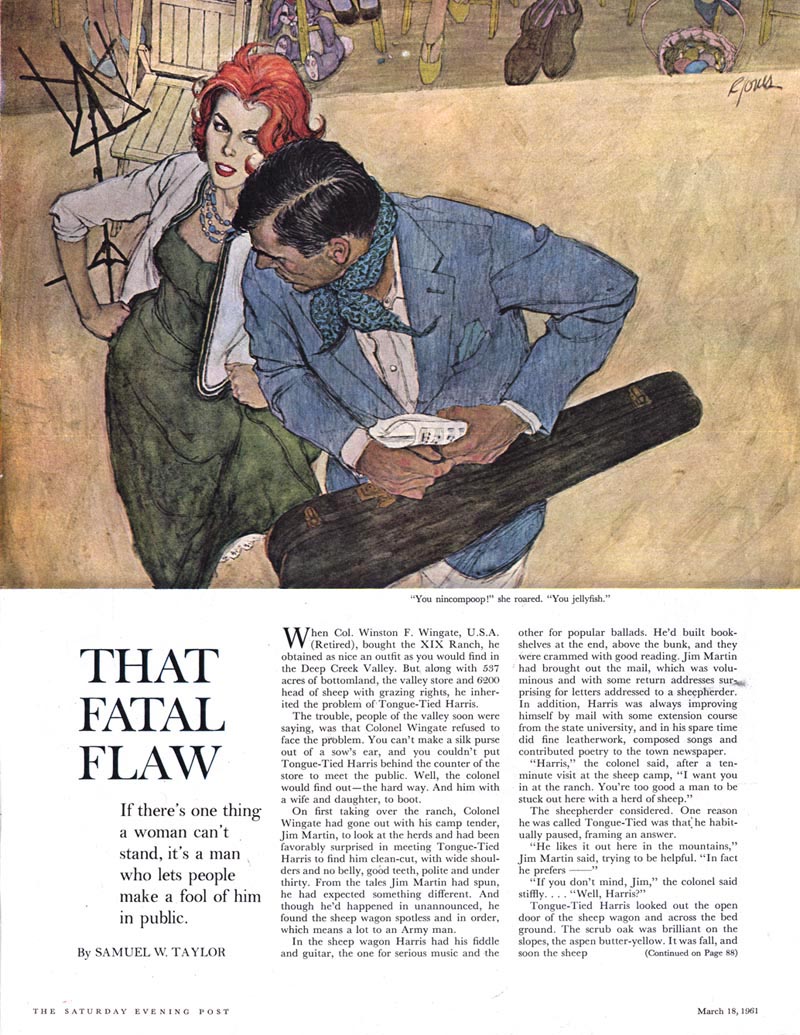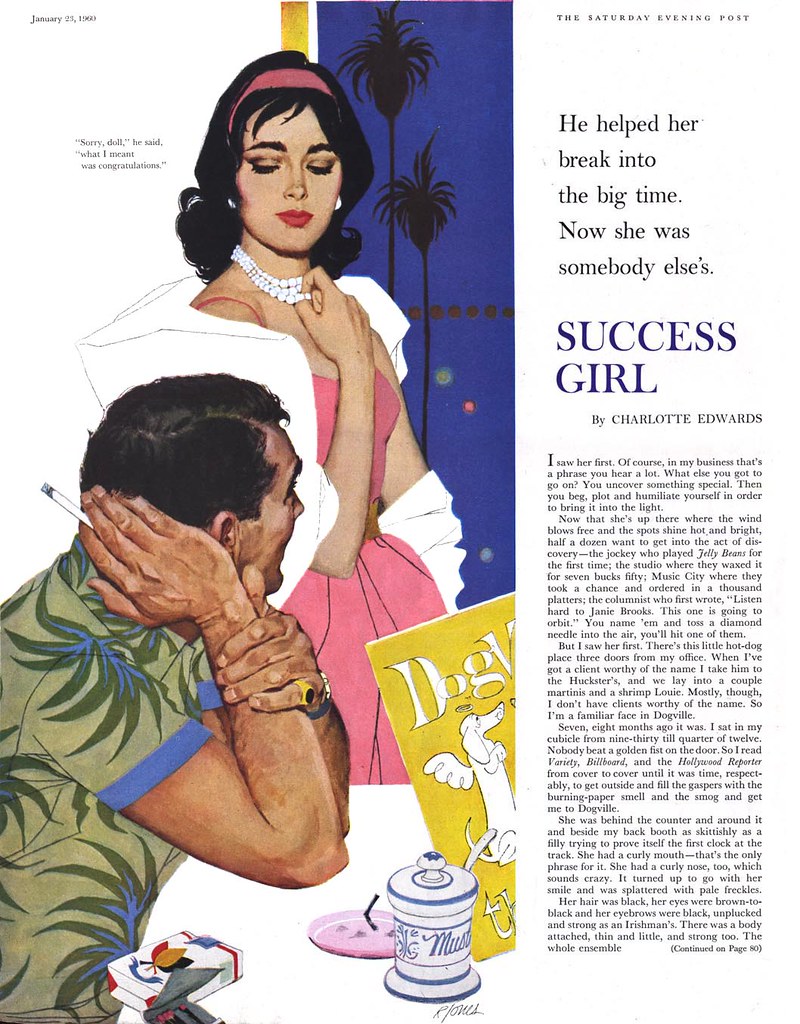When I spoke with Bob earlier today he said, "I enjoyed doing everything. I enjoyed the challenge of saying, "Let's see if I can do this."

When Neil Shapiro interviewed Bob for his thesis on The Cooper Studio (a version of which later appeared as an article in Illustration # 16) Bob said:
" I started out as a kind of a cartoonist/decorative/humorous artist. Then I saw what these other guys were doing -- Coby (Whitmore), Joe (Bowler), Bernie D'Andrea, Jon Whitcomb -- & I thought well, if this boy/girl stuff is what they are doing at the studio, I'd better get with it. Frank Kilker, the art director at The Saturday Evening Post, for whom I'd done some work, said, "You can draw, you can paint -- why don't you try this more realistic look?" So I did some samples. They said "this is fine", & the Post sent me a manuscript. I worked for them for about six years doing realistic stuff -- all from the influence of the Cooper Studio. It was done out of desperation -- I had a mortgage & four kids. I had to do something to get work."

What Bob would really have loved to focus on was the sort of 'humorous realism' he admired so much in the work of artists like Al Dorne and James Williamson but, he told Neil, "there wasn't much work around, at least for me at that particular time."
In spite of all that, Bob managed to sneak in a humorous touch here and there even when he was doing his 'straight' style (as in the example below). When Neil shared the comments from his 1996 Bob Jones interview with me, he added the following...
"When I said that even though he claimed the realistic work was done out of desperation, it was loose & free & sophisticated, he replied "...If you can draw & paint, & understand what is going on, you can do anything from cartoons to the Sistine Chapel! Drawing is drawing, whether it is realistic or not."
"Interesting, eh? I was really impressed by the matter-of-fact recitation of his working decisions."

Recently I discovered the Bob Jones piece below, from a 1958 Cosmopolitan magazine. As Bob's realistic romance style goes, it predates by a year all the Bob Jones romance art I've found in the Post. But Bob is quite convinced that Post AD, Frank Kilker never saw this piece, and that it wasn't the basis for Bob getting those boy/girl story assignments from Kilker.

"Frank Kilker used to come down from Philadelphia to Cooper's once a week," says Bob. "I had been on one of those Air Force trips the guys went on... and I did a realistic painting of a fighter dropping a napalm bomb. He was kind of impressed by that and said, "Gee, you can draw, you have a good sense of colour... I'll send you a 'regular' script, with realistic people."
"I said "OK" (he chuckles) " And that's how that happened."

One thing I noticed as I compiled images for this post was what appeared to be a reoccuring female character in a lot of Bob's romance illustrations. Bob thinks this might be Phyllis Newell, a model that many of the Cooper artists used frequently.

For the next couple of years, around 1960 - '61, the Post became a steady client for Bob's romance art. "The Post paid $600 for a single page illustration," he says, "but I tell ya, after you paid your modelling fees and all that, $600 didn't go very far."
I asked Bob if all those romance illustrations for the Post ever lead to him getting assignments for paperback romance covers. He says, "Yes it did. I did a few... but most of the paperback covers I did were mostly humorous. There were so many guys who were so much better than I was at romance art. That's such a special art."

Here's a fun thing I noticed: almost hidden in this 1960 romance illustration, a drawing of a cartoon dog hints at Bob's past...

... and what lay ahead for him.
Tomorrow: The Esso Tiger
Thanks for the beautiful Jones artwork and info.
ReplyDeleteMuch like Hawley and McGinnis, I think the background in cartooning gives Jones' more realistic work that much more appeal.
S.
Shane; That's a very interesting observation - one I agree with.
ReplyDeleteHere's something interesting and (perhaps) relate to that thought: Bob is a life-long member of the Society of Illustrators. I asked him why he never joined the National Cartoonists Society. He thought quite a while before answering. Though so much of his work could be considered cartooning, he said he always felt that he was an illustrator - especially considering the company he kept and the Cooper studio. He has tremendous affection and respect for cartooning - but I don't think he thought of himself as a cartoonist.
Yikes! Head check needed. I remember that IRS computer illustration form my younger days, as my mom subscribed to all those pubs. It still makes me chuckle and shows both sides of him. Too cool.
ReplyDeleteand I mean that as praise. To me , the ability to be amusing, to cartoon, and to draw with realism as well, is such a gift, to the artist and to the audience!
ReplyDeleteThe Fatal Flaw down-shot angle and the colorful Love Is A Waiting Game art are especially nice.Success Girl looks great as well.
ReplyDeleteI LOVE his works!! Finally found some info on him. Thank you! lol. I saw a piece of his work in the Saturday Evening Post and the signature looks like R Jones.
ReplyDeleteI just spent 30 min searching for R Jones but it's such a common last name, I couldn't find anything. When I search for the Post, it's mostly about Leyendecker, Rockwell, or Wyeth.
I'm so glad I found your post. I LOVE his composition and the mood of the artworks. They are so beautiful :)
I picked up a HUGE piece of Bob's original art at the San Diego Com last year. It's a humourous illustration of American Naval soldiers capturing a Nazi submarine. Does anyone know where I might be able to find out what it was used for?
ReplyDelete